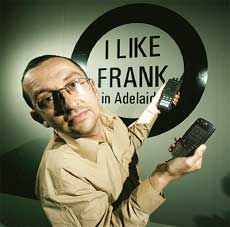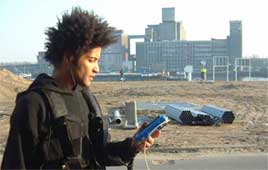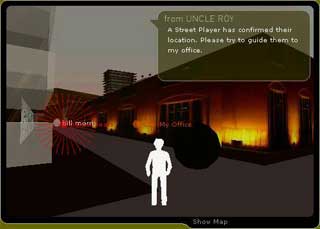 Well... when i write Blast Theory, i mean one of its members: Matt Adams (i took some extremely loosy pictures of him during his talk, so the portrait of him was stolen on The Age.)
Well... when i write Blast Theory, i mean one of its members: Matt Adams (i took some extremely loosy pictures of him during his talk, so the portrait of him was stolen on The Age.)
Matt Adams started by giving a brief history of Blast Theory then explained with more details their latest work: The Day of the Figurines.
In the beginning, Blast Theory was particularly interested in British clubbing culture, they were trying to make out art in clubs in the early '90s. Clubbing at the time wasn't a branded activity like it is now (clubs selling their t-shirts and other "merchandising".) Matt background is in theater and he was interested in how people were staging themselves in clubs. In clubs you have a certain control: you can decide to be and stay a spectator or to be the center of attention, to become part of the show. Clubbing were a very fluid space. THe other main interested was: how do you find and build an audience? how does it form? Visual art is usually shown in galleries, galleries have their audience. Artist have a very personal dialogue with their work and get their audience via the gallery. So matt wanted to find other ways to find new audience.
This reflected also a political interest influenced by the Russian constructivism of the '20s and also by the radical forms of theatre that emerged in the 60s and 70s.
Matt wanted to see how culture could have a transformative role and to make art works which are not narrative. Stories have limits. None of us lives a linear life, our life is more fragmented. Looking for works which would be non-narratives while being also accessible for a broad public, he found out that there was already something out there that had these two qualities: Games!
Games are entertainable, readily understandable, interactive and non-narrative.
In the meantime, he had lost interest in clubs which had lost their fluidity.


Can You See Me Now?
Blast Theory's first attempt to use the street and mobile phones was Can You See Me Now?, commissioned in 2001 by the Art Council of England and the BBC. Why using mobile phones? in 1998-1999, the use of mobile phones was rising, they were becoming ubiquitous and thus became a new transformative technology. Internet is not as transformative as mobile phones. A small number of people have internet at home in some countries. Mobile phone is accessible, there's a very low barrier of entry (unlike the walkman which was a status symbol when it was launched). A study in the UK showed that the proportion of homeless people who own a mobile phone is higher than the proportion of people who have a home and a mobile phone. The mobile phone is also the first thing that immigrant buy when they arrive in the UK. The device is unusually well disiminated in our culture.
In 2000 and 2001, location and 3G were coming with all kinds of promises. Blast THeory wanted to come up with uses of these technologies which were not revolving around commerce and marketing (find the nearest McDonald's, etc.)
As Sadie Plant said "The mobile phone has privatized the phone book." It's an act of trust and reciprocity to give your phone number. In 2001, Blast Theory was thus looking for ways to address these factors. Matt Adams said the Can You see me now was rather primitive, it's a chase game in which online players and players in the streets compete against one another. Why such a simple format? Two reasons: the technical challenges were big and it was necessary to make players easily understand what was going on.
The game was developed in collaboration with the researchers of the Mixed Reality Lab in Nottingham.
People found the game very adrenaline-charged, even if they were only playing online. The walkie-talkie audio element made the game very compelling: listening to the player in the street struggling with traffic, snow, breathing heavier because he or she was running up a hill, etc. The audio element made the players feel intimately connected.

Uncle Roy All Around You

